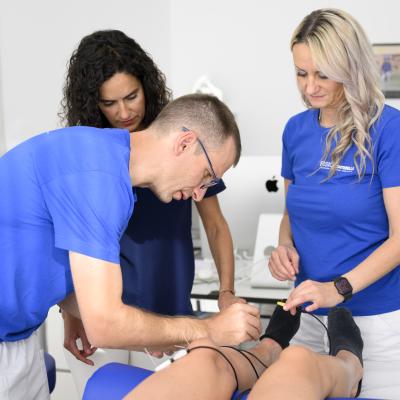Dry Needling (DN) refers to the use of sterile, disposable acupuncture needles for the treatment of pain and disorders of the musculoskeletal system, which can be guided with an ultrasound to allow the technique to be more targeted and precise in the execution, consequently improving its performance and the end result.
The concept of "Trigger-Dry Needling" is understood as the treatment of myofascial trigger points (MTrPs) with DN. Although DN uses the same needles, it has nothing in common with the classical acupuncture treatment. DN is a minimal invasion technique and for which special rules must apply. There are various models of treatment in this regard, but the most widely used is the trigger point model according to Travell and Simons (1983, 1992 and 1999).
DN originates with the MTrPs injection techniques described first by Steinbroker in 1944 and then by Travell in 1968. The two researchers were able to attribute the treatment effect not to the injected substance but to the puncture of the MTrP itself, which lies in the typical contracted band, causing a local twitch as reaction.
The first publication in a Peer Reviewed Journal regarding DN is attributed to Lewit in 1979. Hong, in 1994, showed the local twitch in the contracted band during the treatment and demonstrated how the mechanical effect of the needle in an MTrP is more important than the injected substance.
Further studies came to the same conclusion, showing how the DN technique is as effective as an injection (Cummings & White in 2001 and others in 2007).
In the book that appeared in 2011, "Myofasziale Schmerzen und Triggerpunkte - Diagnostik und evidenzbasierte Therapie - Die Top-30-Muskeln," by Reilich, Gröbli and Dommerholt, the various models of DN are described and numerous practical descriptions of the technique are included (Reilich, Dommerholt & Gröbli, 2011).
What is it used for?
Dry Needling is a treatment that uses very fine needles without any medication to reach myofascial trigger points. It is used to treat pain and dysfunction caused by muscle problems, for example in headaches, spine and limb pain, muscle contractures, TMJ dysfunction, piriformis syndrome, and other issues.
Dry Needling Techniques
There are three main techniques of Dry Needling:
- Deep Dry Needling (DN)
- Superficial Dry Needling (SDN)
- Intramuscular Stimulation (IMS)
Deep DN is the most commonly used and involves inserting the needle directly into the Trigger Point or taut band. This stimulation causes a local twitch response (LTR) of the taut band. After the LTR patient often report a feeling of relaxation, a sign that the “right” MTrP has been treated. There is evidence to support the hypothesis that the therapeutic effect of the LTR is also related to the reduction of local inflammation and relaxation of fascial adhesions.
In SDN according to Baldry (2005), needles are inserted in an oblique direction and at a depth of 3 to 4 mm in the area directly above the Trigger Point; spinal reflexes as well as spinal and cortical circuits responsible for pain inhibition are thus activated.
Intramuscular electrical stimulation (IMS) according to Gunn (1997) involves the insertion of at least two needles into the taut band followed by low-dose TENS stimulation. IMS, along with the Trigger Point-Dry Needling, is considered "Deep Dry Needling" (DDN).
The choice of the Dry Needling technique should be agreed upon and dosed appropriately with each patient.
Safety measures, contraindications and possible complications apply to any form of DDN.
Contraindications:
- Acute systemic infections with or without fever
- All cases of acute emergency
- Patients anticoagulated or with coagulation problems
- No clear agreement by the patient for DN therapy
- Sensitivity disorders (peripheral polyneuropathy)
- Lymphedema or situation of removal of lymph nodes
- High risk of infection
- Skin problems
- Tumors
- Hematomas










